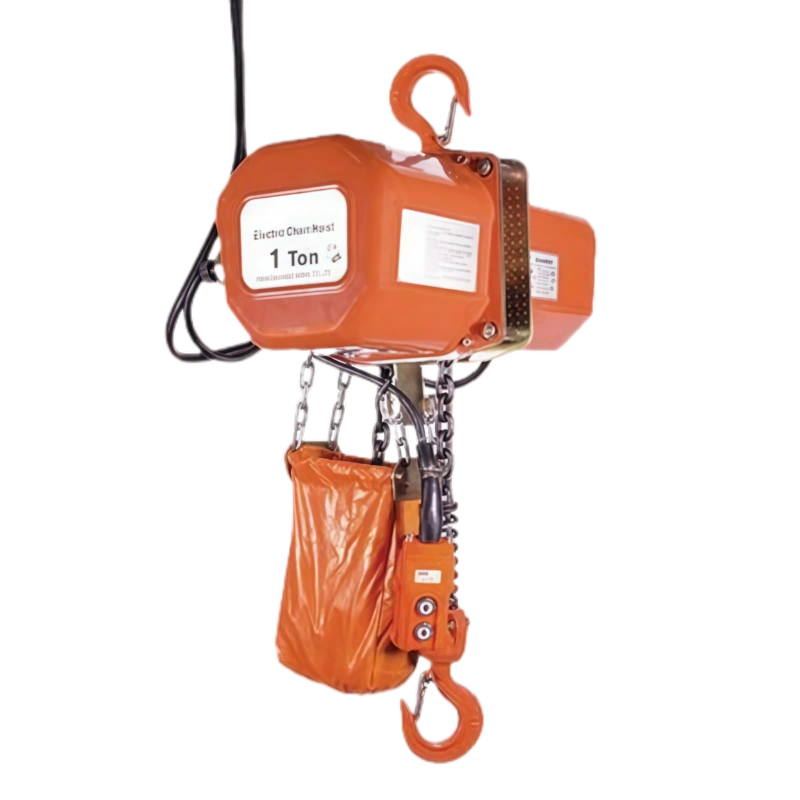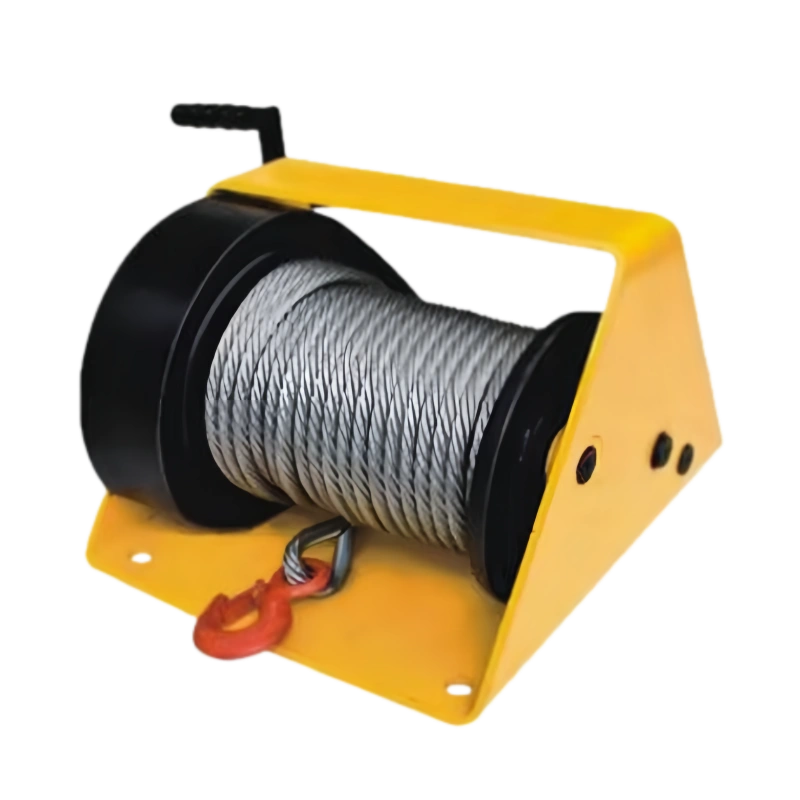ELECTRIC HOIST CHAIN BLOCK SPECIFICATIONS
| Model | VKL-0.5A | VKL-1.0A | VKL-2.0A | VKL-3.0A | HHSY-3.0B | VKL-5.0A |
| Capacity (t) | 0.5 | 1 | 2 | 3 | 3 | 5 |
| Standard lift(m) | 3 | 3 | 3 | 3 | 3 | 3 |
| Test load (kn) | 6.25 | 12.5 | 25 | 37.5 | 37.5 | 62.5 |
| Motor power (kw) | 0.8 | 1.6 | 1.6 | 1.6 | 3 | 3 |
| No. of load chain fail lines | 1 | 1 | 2 | 3 | 2 | 3 |
| Diameter of load chain(mm) | 7.1 | 7.1 | 7.1 | 7.1 | 9 | 9 |
| Lift speed (m/min) | 7 | 7 | 3.5 | 2.3 | 4 | 2.6 |
| Net weight (kg) | 50 | 55 | 60 | 65 | 78 | 85 |
| Exter weight per meter of extra lift(kg) | 1.1 | 1.1 | 2.2 | 3.3 | 3.5 | 5.3 |
ELECTRIC HOIST CHAIN BLOCK FEATURES
Safe Hook: Prevents hook breakage under load.
Motor Protection: Over-temperature safeguard for motor durability.
24V Safe Operation: Low voltage buttons for safer use.
Limit Switch & Load Limiting: Protects against overloading.
Single/Three-Phase Power Compatibility: Versatile for multiple power sources.
CE Certified: Meets rigorous safety standards.
Double Brakes: Dual braking system for enhanced safety.
Lightweight Aluminum Shell: Strong and efficient cooling.
Heat-Treated Alloy Steel Gears: Reliable and durable for long-term use.
Antiphase Protector: Protects against wiring errors.
Forged Hooks: High-strength, secure load handling.
Compact Motor: Efficient and low power consumption.
Durable Hoist & Chain Container: Long-lasting and portable.
INSTRUCTIONS & CAUTIONS
Proper Installation and Mounting
Ensure your electric chain block hoist is mounted securely to a stable and strong structure, such as a beam or trolley that can support the hoist’s full rated capacity. If the hoist isn’t properly aligned or leveled, it could lead to malfunction or accidents during use. Take extra care when installing to guarantee a safe and smooth operation.
Avoid Overloading the Hoist
It’s crucial to never exceed the hoist’s rated capacity. Overloading can strain the motor, damage gears, or even cause the hook to break. Use the hoist’s limit switch and load-limiting features to help monitor weight and prevent overloading. This simple step ensures long-lasting performance and reduces safety risks.
Regular Maintenance and Inspection
Regular checks and maintenance are essential for keeping the hoist in top condition. Periodically inspect the chain, motor, hooks, and braking system for any signs of wear or damage. If you notice any issues, address them immediately by contacting a qualified technician. Routine maintenance not only prevents breakdowns but also extends the life of your equipment.
Electrical Safety
Before operating the hoist, always ensure that all electrical connections are secure and properly insulated. Use a grounded power supply and check wiring for any signs of damage. Never attempt electrical repairs unless you’re qualified. For additional safety, the hoist uses a 24V control button to minimize electrical risks and keep operations safe.
OUR ADVANTAGES
Customizable to Your Needs
Every business is different, and that’s why we offer custom-engineered solutions. We don’t just sell equipment; we design it to meet your specific needs. Whether you need a slight modification or a completely bespoke design, our expert team works closely with you to deliver the best solution. You get equipment that works perfectly for your business, maximizing productivity and efficiency.
Rigorous Quality Control and Certifications
Quality and safety are at the heart of everything we do. We apply strict quality control measures to each product, ensuring it meets global standards. With carefully selected materials and thorough testing, our equipment is built to last. Plus, all our products are fully certified, giving you peace of mind knowing they are reliable, durable, and compliant with industry regulations.
Streamlined Sourcing and Efficient Logistics
Powerful Machinery simplifies your procurement process with our one-stop sourcing. You can rely on us for a complete range of lifting equipment, so you don’t have to work with multiple suppliers. Our logistics team ensures timely and safe delivery to your location, whether it's a bulk order or urgent shipment. We take care of all the details, so you can focus on your core business.
Comprehensive After-Sales Support
At Powerful Machinery, we believe in long-term partnerships, not just transactions. Our dedicated after-sales team provides expert assistance with installation, maintenance, and troubleshooting. If you face any issues, we’re quick to respond, ensuring minimal downtime. Our commitment to reliable support ensures you always have the help you need to keep your equipment running at its best.
FAQ
What is an Electric Chain Hoist?
An electric chain hoist is a powerful lifting device designed to lift heavy loads with ease. It uses an electric motor to drive a chain, which moves the load vertically. Commonly used in manufacturing, construction, and warehouses, these hoists are efficient, easy to use, and capable of handling large loads safely. They’re ideal for environments where speed, precision, and heavy-duty lifting are required.
How to Install an Electric Chain Hoist?
Secure to a Stable Structure
Mount the hoist to a strong, stable overhead structure like a beam or trolley. Ensure the structure can safely support the hoist’s load capacity.Check Alignment and Leveling
Ensure the hoist is properly aligned and leveled for smooth, efficient operation. Misalignment can lead to issues during use.Verify Electrical Connections
Double-check that all electrical connections are secure, properly grounded, and wired to the correct power supply to prevent any safety hazards.Follow Manufacturer’s Guidelines
Always refer to the manufacturer’s installation manual to ensure correct installation and safe operation. Adhering to the provided guidelines helps prevent issues down the line.
How Do Electric Chain Hoists Work?
An electric chain hoist works by using an electric motor to drive gears that move a chain. The chain is wound onto a drum, and as the motor turns, it either raises or lowers the load attached to the hook. This system allows precise and controlled lifting. Electric hoists are efficient and easy to operate, making them a reliable choice for handling heavy loads quickly and safely in industrial environments.
Electric Chain Hoist Inspection Checklist
Check the Chain for Wear or Damage
Inspect the chain for signs of wear, kinks, or damage. Replace it if necessary to ensure smooth operation and safe lifting.Inspect the Hook
Ensure the hook is free from cracks, bends, or any deformation. A damaged hook can pose serious safety risks.Test the Brakes
Test the brake system to ensure it engages smoothly and effectively. Faulty brakes can lead to dangerous situations during lifting.Examine the Motor and Wiring
Inspect the motor and electrical wiring for any signs of wear, overheating, or loose connections. Damaged wiring can cause electrical failures or safety hazards.Verify the Limit Switches
Ensure the limit switches are functioning properly to prevent over-travel and protect the hoist from damage or malfunction.
How to Maintain an Electric Chain Hoist?
Lubricate the Chain, Gears, and Motor Components
Regularly lubricate these parts to prevent friction, wear, and corrosion, ensuring smooth operation and extending the hoist’s lifespan.Inspect the Brake System
Check the brake system to ensure it is functioning properly. Worn or damaged brakes can compromise safety and performance.Clean the Hoist
Keep the hoist clean by removing dust, dirt, and debris. Regular cleaning helps prevent buildup that could interfere with moving parts.Check the Electrical Components
Inspect the electrical components for any signs of wear or damage. Damaged wiring or connectors can cause electrical failures or safety issues.Ensure the Hoist is Not Overloaded
Always check that the hoist is used within its rated capacity. Overloading can strain the motor and other components, leading to premature wear.
How Do I Know When to Replace My Electric Chain Hoist?
If your electric chain hoist is frequently malfunctioning or showing signs of wear such as motor overheating, chain damage, or operational inconsistencies, it might be time for a replacement. If the hoist is older and used regularly, it may no longer meet safety standards or function efficiently. Always consult with a professional to assess whether a replacement is necessary or if repairs can extend its life.
What Are Common Problems with Electric Chain Hoists?
Common issues with electric chain hoists include motor overheating, worn chains, faulty brakes, and electrical problems like wiring issues or motor failure. These problems are often caused by poor maintenance, overloading, or using the hoist beyond its capacity. Regular maintenance and following the manufacturer’s instructions will help prevent these issues and ensure your hoist operates safely.
How Do I Troubleshoot Electrical Issues with My Electric Chain Hoist?
If your electric chain hoist is experiencing electrical issues, first check the power supply and ensure there are no loose connections or damage. Inspect the control circuit and wiring for any faults. If the motor is not starting, it could be due to a blown fuse, faulty switch, or wiring issue. It’s best to call a professional to address these problems, as electrical repairs can be complex and hazardous.
What is the Difference Between a Manual and Electric Chain Hoist?
Power Source
The key difference lies in their power source. Manual chain hoists require physical effort to operate, while electric chain hoists are powered by an electric motor, making them easier to use for heavy lifting tasks.Lifting Capacity
Electric chain hoists can lift much heavier loads compared to manual hoists. They are designed for high-capacity, high-frequency lifting, while manual hoists are best suited for lighter loads.Speed and Efficiency
Electric chain hoists operate much faster than manual hoists, making them ideal for high-volume operations. Manual hoists are slower and require more effort, which makes them better for occasional lifting in low-demand settings.Application Flexibility
Manual chain hoists are more versatile in small or confined spaces where power sources are unavailable. Electric chain hoists, on the other hand, require a reliable power supply and are best suited for environments where efficiency and lifting capacity are priorities.
How Can I Increase the Speed of My Electric Chain Hoist?
To increase the speed of your electric chain hoist, consider choosing a model with variable speed control or upgrading to a faster motor. However, be cautious not to compromise safety by lifting loads too quickly. Faster speeds can be beneficial in high-demand environments, but always ensure that the hoist’s load capacity and safety features are in line with the intended use.




